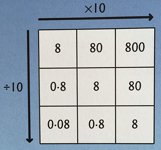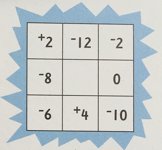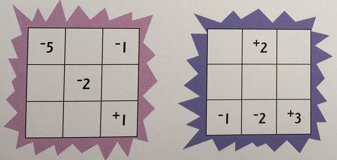Commas and spaces
Discuss with pupils the way large numbers are written. Ask them to find examples in books, newspapers and magazines.
When grouping the sets of three digits in large numbers, spaces are more frequently used than commas when the numbers are typed, for instance 32 579 843.
Explain that the space or comma is a good way of showing where the words thousands and million are used when saying the number aloud.
Powers of 10
Discuss ways in which mathematicians use shorthand: = + ÷ √ π
Explain that large numbers can also be written using shorthand:
100 = 10 x 10 = 102
1000 = 10 x 10 x 10 = 103
18 x 105 = 1 800 000
· In pairs, pupils give each other a number such as 24 x 104. This is written down and read back in full as above.
· A target number is given to a partner, such as 245 000 000. They try to write this in shorthand using powers of ten.
Rounding numbers
Write a large number on the board, such as 38 465. Ask pupils to round this to the nearest 10, 100, 1000 and 10,000. Discuss the four approximations and the way they become less and less accurate.
Repeat with other five- and six-digit numbers.
Large number words
· These are the prefixes used for SI units (the international system of units):
exa: 1018 giga: 109
peta: 1015 mega: 106
tera: 1012 kilo: 103
· Discuss ways in which we can work out the value and relationships between large numbers by looking at the beginnings of words. For instance: kilo, mega and giga. Giga is often used in computing for very large numbers, such as a gigabyte. It stands for 1 000 000 000 (a thousand million).
· Talk about large numbers such as millions, billions and trillions. Explain how a new word, googol, has been invented to describe 1 followed by a hundred zeros.
Make a million
Each pupil enters a six-digit number in the calculator without the other seeing.
Pupils then take turns to ask for a digit at random, for example:
The value of the digit (in this case 70 000) is subtracted from Player B’s total and added to Player A’s calculator total.
The game continues until one player goes beyond 999 999 or the other player goes below zero.
Calculator constants
Organisation: pairs or groups
Pupils take turns to use the constant x 10 on the calculator by inputting 10 x x = and another input, such as 58. The partner predicts what the display will show when the equals key is pressed repeatedly.
This can be repeated for other starting numbers and developed by changing the constant to x 100.
Arrow cards
Each pupil has a set of Arrow cards.Pupils combine their Arrow cards to make numbers.
· Play ‘Show me’ asking questions about place value.
Show me a number which has 2; 9; 3; … in the thousands column.
· Include multiplying and dividing numbers by 10, 100 and 1000:
Show me: 148; 250; 697; 438; … multiplied by 10.
Show me: 19; 27; 130; 566; 730; … multiplied by 100.
Show me: 3000; 14 000; 32 000; … divided by 1000.
Discuss ways of checking how many zeros the answer will have.
Counting stick
Explore negative numbers. Call one end of a counting stick 10 and the other -10.Hold the stick in the centre to show zero.
· Point to each division in turn and ask for the appropriate number.
· Point to positions randomly, including mid points, and ask for the appropriate numbers.
Repeat the activities with divisions from 0 to -20 and 0 to -100.
Explore decimals. Call one end of a counting stick zero and the other end 1.
· Point to each division in turn and ask for the appropriate decimal number.
· Point to positions randomly and ask for the appropriate decimal numbers.
Repeat the activities, calling one end zero and the other end 0.1.
· If pupils are confident with this activity point to the mid points between the divisions to generate decimal numbers such as 0.025, 0.045, 0.085, …
Number lines
Each pupil has a set of Blank number lines. Give them two consecutive numbers to start and finish the first number line. Pupils write the missing numbers in between.
Ask pupils to choose any two consecutive numbers from this completed number line and write these as the start and finish numbers of the next line. The missing numbers are again filled in and the activity repeated for the third number line.
Discuss the use of hundredths and thousandths and compare the number lines.
Individually or in pairs this activity can be repeated for the next three number lines using different consecutive starting numbers.
Washing lines
Use a short length of washing line to which pupils clip numbers using small bulldog clips or clothes pegs.
Clip a decimal point to the line and decide upon the range of decimal numbers to use.
Start with a decimal number such as 3.92, then ask pupils to:
Make it ten more.
Divide it by 10.
Add 0.01 to it.
Halve it.
Include:
· Multiplying and dividing by 10, 100,…
· Increasing and decreasing by 10, 100, ….
· Rounding to one or two decimal places.
Mental numbers
Pupils sit with their eyes closed and imagine a number written on the inside of their eyelids.
Imagine this number to be 125.839.
Which digit is in the tens column? Which digit is in the hundredths column?
Which digit is in the hundreds column? Which digit is in the tenths column?
Change over the positions of the 8 and 5. What is the new number?
Make the number one more. What is it now?
Now make this number 0.1 more. What is the new number?
Subtract 1000 from the number. What is the number now?
Change the starting number.
Calculator constants
Organisation: pairs or groups
Pupils take turns to use the constant ÷ 10 on the calculator by inputting 10 ÷ ÷ = and another input, such as 6. The partner predicts what the display will show when the equals key is repeatedly pressed.
This can be repeated for other starting numbers and developed by changing the constant to ÷ 100.
Draw a game grid like this:

Turn over the top card and place it on the grid in any position you want.
Continue this, turning over six cards and placing them one at a time on the grid.
Check your numbers on the grid. Is the result true?
Look at the four digit cards you have left. Can you make a number with any three of the cards that is smaller than your biggest number and larger than your smallest number?


What has happened to each input number for each column? Write the rules:
- Column A _______
- Column B _______
- Column C _______
- Column D _______
- Column E _______
- Column F _______
If an input number was 75, what would be in column B?
If an input number was 3.18 what would be in column E?
If 17.215 was in column C, what number would be in that row for column D?















